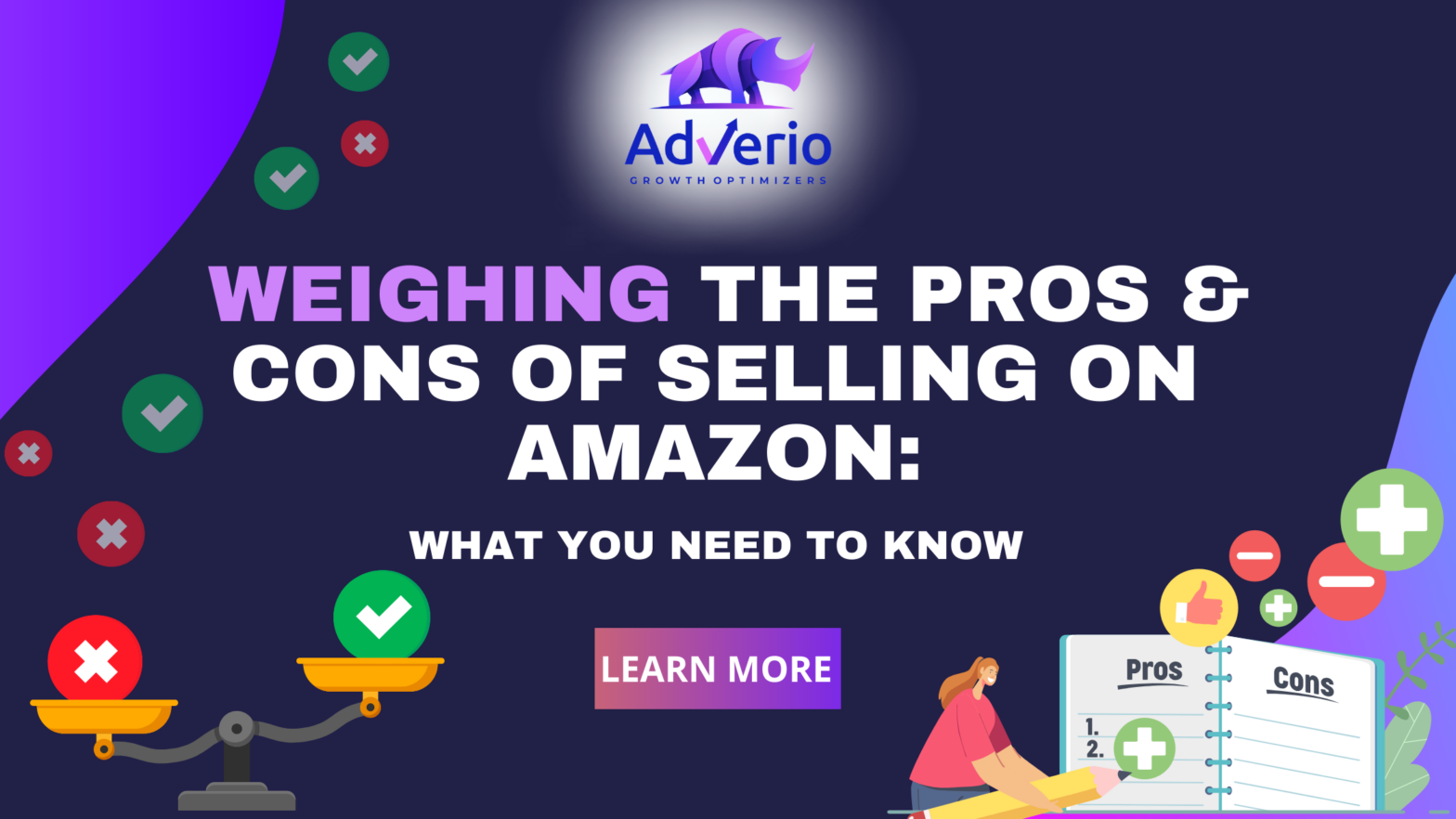In today’s digital age, selling products online has become a lucrative business opportunity. With the rise of e-commerce giants like Amazon, entrepreneurs and businesses can reach a massive customer base and tap into a global marketplace. However, before diving into the world of online selling, it’s essential to weigh the pros and cons.
This article will examine the pros and cons of selling on Amazon, helping you make an informed decision for your business.
Table of Contents
Understanding Amazon’s Marketplace

Before delving into the pros and cons, let’s familiarize ourselves with Amazon’s marketplace. Amazon is the world’s largest online retailer, offering a platform for businesses and individuals to sell their products. With millions of active customers and a user-friendly interface, Amazon provides a seamless selling experience.
When it comes to online marketplaces, Amazon is a behemoth. Founded in 1994 by Jeff Bezos, the company started as an online bookstore but quickly expanded its offerings to include a wide range of products. Today, Amazon sells everything from electronics and clothing to home goods and groceries. It has become the go-to destination for online shopping, with a vast customer base that spans the globe.
One of the key reasons behind Amazon’s success is its marketplace model. Unlike traditional retail stores that solely sell their products, Amazon allows third-party sellers to list their products on its platform. This creates a diverse and extensive catalog of products, attracting millions of customers looking for a one-stop shopping experience.
The Basics of Amazon’s Selling Platform
Amazon’s selling platform offers a variety of features and tools that make it easier for sellers to manage their business. From inventory management to order fulfillment, sellers can efficiently run their operations on Amazon’s platform.
One of the standout features of Amazon’s selling platform is its inventory management system. Sellers can easily track their stock levels, ensuring that they never run out of popular items. This helps to minimize the risk of losing sales due to inventory shortages and allows sellers to maintain a consistent supply of products for their customers.
In addition to inventory management, Amazon also provides sellers with robust order fulfillment options. Sellers can choose to fulfill orders themselves or take advantage of Amazon’s fulfillment services, known as Fulfillment by Amazon (FBA). With FBA, sellers can store their products in Amazon’s warehouses, and Amazon takes care of the packing, shipping, and customer service. This saves sellers time and effort and enhances the overall customer experience by ensuring fast and reliable delivery.
How Amazon’s Marketplace Works
Amazon operates on a marketplace model, allowing third-party sellers to list their products alongside Amazon’s own offerings. This creates a diverse and extensive catalog of products, attracting millions of customers looking for a one-stop shopping experience.
When customers search Amazon’s website for a product, they are presented with a list of options from various sellers. Each listing includes details about the product, such as price, condition, and seller rating. Customers can compare these options and choose the one that best meets their needs.
Once a customer decides to make a purchase, they can add the item to their cart and proceed to checkout. At this point, Amazon handles the payment processing and ensures a secure transaction. After the purchase is completed, the seller is notified and responsible for shipping the product to the customer.
Amazon also provides sellers with tools to optimize their product listings and improve their visibility on the platform. Sellers can create detailed product descriptions, add high-quality images, and even run advertising campaigns to attract more customers. This level of customization and control allows sellers to showcase their products effectively and increase their chances of making sales.
Amazon’s marketplace is a powerful platform that offers sellers a wide range of features and tools to succeed in the world of e-commerce. By leveraging the marketplace model and taking advantage of Amazon’s resources, sellers can reach a massive audience and tap into the immense potential of online retail.
The Advantages of Selling on Amazon
Selling on Amazon comes with its fair share of advantages, making it an attractive choice for many businesses.
When it comes to e-commerce platforms, few can rival Amazon’s reach and influence. With its incredible customer base and global presence, selling on Amazon opens up a world of opportunities for businesses of all sizes.
Access to a Massive Customer Base
One of the significant advantages of selling on Amazon is the access to millions of active customers. By listing your products on Amazon, you can reach a vast global audience, increasing your chances of making sales.
Imagine having your products showcased to millions of potential buyers who are ready to make a purchase. With Amazon’s extensive customer base, your products have the potential to be seen by customers from all corners of the globe, giving your business a significant boost in exposure.
Moreover, Amazon’s customer base is not just large; it is also diverse. This means that no matter what type of products you sell, there is likely a market waiting for you on Amazon. Whether you specialize in electronics, fashion, home goods, or any other niche, Amazon provides a platform where customers actively search for products like yours.
Utilizing Amazon’s Fulfillment Services
Amazon’s fulfillment services, Fulfillment by Amazon (FBA), allow sellers to store their inventory in Amazon’s warehouses. Amazon takes care of storage, packaging, and shipping, saving sellers time and effort.
With FBA, sellers can focus on growing their business without the hassle of managing logistics. Amazon’s vast network of warehouses ensures that your products are stored safely and efficiently, ready to be shipped to customers at a moment’s notice.
Not only does FBA streamline the fulfillment process, but it also enhances the customer experience. Amazon’s reputation for fast and reliable shipping means that customers can enjoy quick delivery times, which can lead to increased customer satisfaction and positive reviews for your products.
Trust and Credibility with Amazon Brand
Amazon is a trusted and well-established brand. By listing your products on Amazon, you gain the credibility and trust associated with the Amazon name. This can boost customer confidence and encourage more sales.
When customers see that a product is sold on Amazon, they often feel more confident in making a purchase. Amazon’s history of excellent customer service, reliable shipping, and hassle-free returns instills trust in buyers, making them more likely to choose your products over competitors.
Amazon’s strict seller policies and customer feedback system ensure that only reputable sellers thrive on the platform. By meeting Amazon’s standards and receiving positive feedback from customers, you can establish yourself as a trustworthy and reliable seller.
Selling on Amazon offers numerous advantages for businesses looking to expand their reach and boost sales. From accessing a massive customer base to utilizing Amazon’s fulfillment services and gaining trust and credibility through the Amazon brand, the benefits of selling on Amazon are undeniable. So, whether you are a small business or a large enterprise, consider harnessing the power of Amazon to take your business to new heights.
The Disadvantages of Selling on Amazon
While there are advantages to selling on Amazon, it’s also essential to consider the potential drawbacks.
High Competition and Market Saturation
One significant challenge that sellers encounter on Amazon is the high level of competition. With millions of sellers on the platform, it can be difficult to stand out among the vast number of similar products. This intense competition means that sellers must find innovative ways to differentiate themselves and their products from others in the marketplace.
Certain product categories on Amazon may be oversaturated, making gaining visibility and generating sales even more challenging. This oversaturation can lead to sellers struggling to capture potential customers’ attention, resulting in lower sales volumes.
Fees and Costs Associated with Selling
When selling on Amazon, sellers need to account for various fees and costs. These expenses can eat into profit margins, especially for low-priced items. Some of the common fees and costs associated with selling on Amazon include:
- Listing fees: Amazon charges sellers a fee for each product listing, regardless of whether the item sells or not.
- Referral fees: Sellers are also required to pay a referral fee for each item sold on the platform. This fee is a percentage of the item’s sale price and varies depending on the product category.
- Fulfillment fees: If sellers choose to use Amazon’s fulfillment services, they will incur additional costs for storage, packaging, and shipping.
These fees and costs can significantly impact a seller’s profitability, especially for those operating on thin profit margins or selling lower-priced items. It is crucial for sellers to analyze their pricing strategies carefully and consider these expenses when determining their selling prices.
Limited Control Over Branding and Customer Relationships
While Amazon offers substantial reach and access to a vast customer base, it comes at the cost of limited control over branding and customer relationships. The Amazon platform focuses primarily on the products themselves, potentially diluting a seller’s brand identity.
Additionally, Amazon handles customer interactions, including customer service and returns, reducing direct engagement between sellers and buyers. This lack of direct communication can make it challenging for sellers to establish and maintain a personal connection with their customers, which is crucial for building brand loyalty and repeat business.
Sellers have limited control over the presentation of their products on Amazon’s website. The platform’s standardized templates and layouts may not allow sellers to showcase their products in the most compelling way or convey their brand’s unique value proposition effectively.
While selling on Amazon offers numerous benefits, such as a vast customer base and extensive reach, sellers must also consider the potential disadvantages. High competition and market saturation, fees and costs associated with selling, and limited control over branding and customer relationships are some of the challenges that sellers may face when using the platform.
By understanding these drawbacks and developing strategies to mitigate them, sellers can make informed decisions about whether selling on Amazon aligns with their business goals and objectives.

Making the Decision: Is Amazon Right for Your Business?
Ultimately, deciding whether to sell on Amazon requires careful evaluation of your business model and goals.
Assessing Your Business Model and Goals
Consider your business’s unique needs, resources, and long-term goals. Selling on Amazon may align with certain business models, such as high-volume sales or global expansion. Evaluate whether Amazon’s marketplace complements your overall strategy.
Evaluating Your Product Line for Amazon’s Marketplace
Not all products may thrive on Amazon’s marketplace. Conduct thorough research to determine if your product has demand and if it fits within the competitive landscape. Consider whether your product can generate sufficient profit margins after accounting for fees.
Considering Other Online Marketplaces
While Amazon is undoubtedly a dominant player, it’s also essential to consider other online marketplaces. Platforms like eBay, Walmart Marketplace, or Shopify may offer different advantages, depending on your business and target audience.
Ultimately, weighing the pros and cons of selling on Amazon is crucial in making an informed decision. By carefully considering the advantages, disadvantages, and specific needs of your business, you can determine if selling on Amazon aligns with your goals and contributes to the growth and success of your venture.
The Key to Success on Amazon
As you contemplate the advantages and disadvantages of venturing into the dynamic world of Amazon selling, it’s important to recognize that success on this platform often hinges on effective product presentation and visibility. This is where Adverio can be your invaluable partner. As you navigate the decision-making process, consider partnering with Adverio to take full advantage of Amazon’s vast opportunities for businesses of all sizes. Explore Adverio’s services today and harness the power of Amazon to drive your e-commerce success.





























